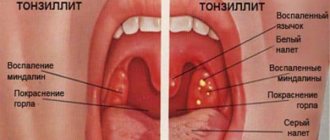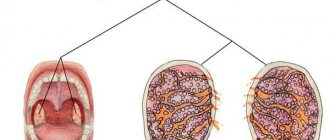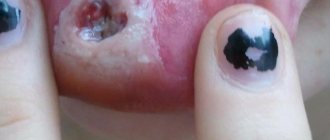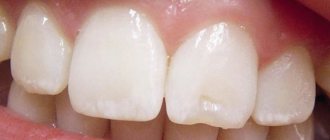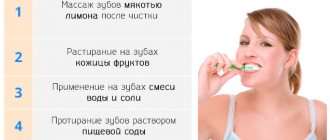How to clean tonsils. We cleanse our tonsils and don’t get sick.
Many of us are now keen on cleansing the body. We cleanse the liver, intestines, kidneys; these organs seem important to us and especially in need of care. But there are also more modest, but no less important organs in our body. And now, on the eve of the cold season, I want to talk about cleansing the tonsils. Nature has provided the tonsils as a protective structure against the entry of various infections into the body, but sometimes the protection fails.
The literature describes more than 80 diseases that are in one way or another associated with a toxic focus located in the inflamed tonsils: diseases of the ENT organs, teeth, nervous, endocrine and cardiovascular systems, spine, digestive tract and many others. Interestingly, health does not always improve after tonsillectomy.
Many problems are explained by the fact that the structure of the tonsils resembles a sponge. The “Sponge” absorbs everything: liquefied food, microbes and bacteria. Once in a favorable environment, bacteria begin to multiply intensively. The body cannot allow such expansion and urgently “puts to use” white blood cells - leukocytes, which penetrate the tonsil tubes (lacunae) and organize a rather active battle there. When they die, the participants in the battle create special enzymes that seem to “melt” the tissues of the tonsils themselves and form purulent sacs. But it is not all that bad. A person, without noticing it, constantly “squeezes out” clogged cavities - during swallowing movements, yawning, tense neck muscles, and turning the head. Therefore, one of the ways to clear the tonsils and treat the throat is the “Lion Pose” exercise. If you are interested, you can compare the color of your tongue before and after the procedure. Of course, it’s better to clean off the plaque, ideally with a silver teaspoon.
The exercise is performed like this: inhale and hold your breath. Open your mouth wide, stick your tongue as far forward and down to your chin as possible. At the same time, press your chin to your sternum. Do this as long as holding your breath is enough. Repeat at least three to five times in one approach.
There are other exercises I would recommend besides Lion Pose. They are especially useful after tonsil removal.
A very simple “Ring” exercise: the mouth is closed, the tip of the tongue rests on the palate, turns back as far as possible and is fixed in this position - the muscles of the larynx and neck are tense; concentration of attention - on the muscles of the neck, larynx and tongue. You need to keep your muscles tense as long as holding your breath allows. Do several approaches. Then gargle with salted water.
Smooth turns and tilts of the head forward, backward and to the sides with obligatory fixation of the head at the end point of the turn will also have a beneficial effect. Such elements are built into many health-improving gymnastics. Regular exercises help get rid of headaches and reduce a double chin. When you feel better, the tonsils can be cleaned for prevention.
Now I’ll tell you about the results. I have been using these simple techniques for the fourth year now, and I consider the main achievement to be that during all this time my throat has never hurt. There were slight runny noses - yes, I admit, there were some, but there were no serious problems. My little son suffered from a sore throat almost every month in the winter; the doctors suggested removing his tonsils, but I flatly refused. They began to engage in cleansing, especially since the child liked this treatment more than the pills, and the exercises were even fun to do. And there are results. That’s why I decided to write, in case someone might find my advice useful.
How to clear tonsils of purulent plugs. Medicines
If the diagnosis is determined to be acute tonsillitis, then treatment usually looks like this. Antibacterial drugs are prescribed, usually broad-spectrum antibiotics - ampicillins, amoxicillins, fluoroquinolones. They actively fight bacteria, which led to the formation of purulent plugs. Already after the first dose, the lacunae begin to clear. The course of treatment, depending on the severity of the disease, lasts on average 7 days. Under no circumstances should you stop taking antibiotics without permission.
Rinse procedure
Additionally, local therapy is necessarily prescribed. It is important to rinse the contents of the tonsils, then the healing process will go faster. Ready-made antiseptic solutions are used - Furacilin, Chlorophyllipt, Miramistin, Iodinol. You can also prepare a mouthwash at home. It could be:
- salt (1 teaspoon) + soda (1 teaspoon) + iodine (3-4 drops) per 200-250 ml of warm boiled water;
- apple cider vinegar (1 teaspoon) per glass of water;
- infusions or decoctions of herbs - sage, calendula, chamomile, plantain, coltsfoot.
The rinsing procedure in the first days of the disease should be carried out frequently - up to 5-6 times a day. It is good to alternate several different solutions, then the therapeutic effect will be stronger. Even after the plugs have disappeared, it is recommended to continue rinsing to completely clear the tonsils of pus.
Local therapy (aerosols and lozenges)
Medicinal sprays are used to relieve swelling and disinfect the mucous membrane. For sore throat with caseous plugs, you can irrigate the throat with Orasept, Cameton, Ingalipt, Yox, Hexoral. You can also gently lubricate the tonsils with Lugol's solution. It cleanses the tonsils well and relieves inflammation. It is only important to remember that sprays cannot be used in children under 3 years of age, and preparations with iodine are not prescribed for iodism and thyroid diseases.
To reduce pain and relieve swelling, you can use lozenges and lozenges (Strepsils, Trachisan, Linkas, Farisil). For chronic tonsillitis, you can take the homeopathic drug Tonsilotren in long courses (several months). Before use, it is important to exclude possible manifestations of allergies to the components of the drug.
Warming and steam inhalations
Inhalations are a good remedy for any throat disease. In the acute period of angina, inhalation is strictly prohibited. But at the stage of recovery and during the period of exacerbation of chronic tonsillitis, they are indicated. The most basic way is to breathe in the steam of boiled potatoes. You can also boil water with a few drops of essential oil (eucalyptus, mint) and breathe for 10-15 minutes. It’s great if you have a special inhaler and nebulizer at home. The best option would be to undergo a course of physical therapy procedures in a clinical setting.
Provided that all comprehensive measures for the treatment of acute tonsillitis are taken, the tonsils will be cleared of purulent plugs in just a couple of days.
How to rinse tonsils at home
Washing the tonsils at home has not lost its relevance in the treatment of tonsillitis. This procedure is often performed in a medical facility, but you can do it yourself. It is enough to know a few simple rules for carrying out the procedure, which will help you get rid of pain and other unpleasant symptoms in the shortest possible time.
Features of treatment
Tonsils are designed to protect a person from the penetration of various bacteria and viruses into the body. They are part of the immune system and effectively perform their function throughout life.
The tonsils consist of a large number of lacunae or ducts, pockets.
If pathogenic microorganisms begin to accumulate in them, an inflammatory process develops and the tonsils cease to perform their protective function.
Very often the phenomenon is accompanied by the formation of pus and white plaque on the entire surface of the mucosa. The presence of tonsillitis may be indicated by an unpleasant odor from the mouth, fever, pain and significant discomfort in the throat.
In this case, when washing the tonsils with special antiseptic solutions, the following can be achieved:
- temperature normalizes;
- as the inflammatory process is eliminated, the tonsils become smaller and thicker;
- pus and characteristic plaque are completely removed from the lacunae, which cannot be achieved by ordinary rinsing;
- the mucous membrane is additionally moisturized;
- Eliminates unpleasant odor from the mouth and other symptoms of tonsillitis.
Methods of cleansing in a medical facility
In the presence of tonsillitis, it is very effective to cleanse the lacunae of the tonsils using a vacuum method, which can only be used in a medical facility. This procedure is traumatic, so it should only be performed by a qualified otolaryngologist . The procedure for vacuum cleansing the tonsils is as follows:
- The larynx is anesthetized because the procedure is unpleasant and painful. Lidocaine is most often used for this.
- The patient sits, lowers his head down and sticks out his tongue. When performing further manipulations, a person must suppress the desire to swallow and hold his breath repeatedly.
- During the procedure, a suction device is placed on the tonsils, which pumps out the accumulated fluid. Then the tonsils are washed with a special solution with a disinfectant effect.
- Cleansing takes about 10 minutes. The average course of treatment is 5-15 procedures. Initially, washing is done daily, and then every other day.
Rules for self-cleansing
How to rinse the tonsils at home so as not to injure them and not provoke the development of complications? To carry out the procedure correctly, skill is required. If the patient cannot do everything on his own, it is better to ask for help from loved ones.
To wash the lacunae, it is recommended to purchase a special syringe for intralaryngeal infusions . It is equipped with a long nozzle, which will allow you to clean more efficiently. Antiseptic solutions can also be prepared independently, using one of the recipes of folk or traditional medicine.
The cleansing procedure is as follows:
- The person is advised to take a comfortable position, preferably in front of a mirror, in order to clearly see the tonsils.
- The procedure is performed over a sink or small basin.
- The syringe with the collected solution must be brought as close as possible to the tonsils and sharply press the plunger. The stronger the pressure of the liquid, the more effectively the purulent plugs will be removed.
- You can try to carefully insert the syringe into the lacuna, but this is quite traumatic. If the patient is doing cleansing for the first time, it is better not to do this.
- The disinfectant solution should not be swallowed. After washing, it will contain pathogenic bacteria and pus, so the liquid must be spat out.
Also, in the presence of tonsillitis, there is an alternative method of washing the tonsils. It is less dangerous and can be used by everyone.
To clean, just take a cotton swab, soak it in a disinfectant solution and wipe the problem areas.
In this way it is easy to remove plaque that forms at the initial stage of the disease. It is recommended to remove purulent plugs with a cotton swab. It needs to be moistened in Lugol or another antiseptic. Apply a little pressure to the tonsils with a cotton swab, after which the plugs come out.
Recipes for preparing disinfectant solutions
To wash the lacunae of the tonsils at home, you can use one of the recipes:
- Furacilin solution. This drug can be purchased at a pharmacy and is inexpensive. To prepare an antiseptic solution, you need to dissolve two Furacilin tablets in a glass of warm boiled water. The cleaning procedure should begin after the sediment has completely disappeared from the liquid. To do this, the solution must be stirred periodically and allowed to stand for about 15-30 minutes.
- Saline solution. To prepare the medicine, you can use regular table salt or sea salt without any additives. Additionally, add a little soda or a couple of drops of iodine. The traditional recipe for the solution is as follows: 1 glass of water is mixed with a teaspoon of salt.
- Alcohol solution of Chlorophyllipt . This drug is very effective in the treatment of tonsillitis and is often used to rinse the tonsils. It has wound-healing, antiseptic properties and is able to enhance the natural protection of tissues. To prepare the medicine, Chlorophyllipt should be mixed with water in a ratio of 1:5. Washing with this drug can be done up to 3 times a day.
- Infusions of medicinal herbs. For tonsillitis, it is recommended to use medicinal preparations with disinfectant, anti-inflammatory and regenerating effects. You can also use infusions prepared from only one plant - calendula, chamomile, oak bark, sage, peppermint and others. To cleanse the tonsils, mix a spoonful of the mixture with a glass of boiling water. When the liquid has cooled, it must be filtered and used for its intended purpose.
- Propolis. You need to use alcohol or water tincture. In the first case, it is mixed with 100 ml of warm water in the amount of one teaspoon. The prepared medicine will take on a cloudy white color, which is completely normal. When using a water tincture, it is recommended to mix it with liquid in a ratio of 1:3.
When treating tonsillitis, in addition to regular rinsing, do not forget about careful oral hygiene . To remove food debris after eating, rinse with warm water. During an exacerbation of the disease, it is recommended to completely avoid eating hard, hot foods, which can injure tissues and lead to serious complications.
Source: https://FitoInfo.com/lechenie-travami/uxo-gorlo-nos/promyvanie-mindalin.html
How to clean tonsils in the hospital. Rinsing the tonsils with a syringe
Carrying out the procedure in a clinic setting
This method is the simplest and most common. At the moment, it is included in the list of free services under the compulsory medical insurance program. Syringe rinsing can be done in a regular clinic.
To carry out the procedure, the doctor uses a syringe without a needle with a cannula (a metal curved tube) attached to it. He inserts the nozzle directly into the lacuna, breaking the plugs if necessary.
The syringe contains a solution of an antiseptic drug - furatsilin, potassium permanganate, etc. The liquid is pumped into the lacuna, after which it is poured along with the purulent contents into the patient’s mouth. The patient is asked to spit it into a cuvette. In this way, the palatine tonsils are washed; the pharyngeal tonsils are quite difficult to reach even with a curved cannula.
After the procedure, the tonsils are lubricated with Lugol's solution and collargol (a silver-based drug). The patient is advised to abstain from hard, scratchy foods for the entire treatment period. The effectiveness of the procedure largely depends on the professionalism of the doctors. An inexperienced specialist can damage the walls of the lacunae, which will ultimately lead to the spread of infection or the formation of scars that will worsen the condition and functioning of the tonsils.
Carrying out the procedure yourself
Some patients with chronic tonsillitis try to repeat the procedure at home. A syringe for washing tonsils can be purchased at a pharmacy. But despite the apparent simplicity, it is better to consult a doctor. It is impossible to maintain the required sterility at home, and a non-specialist can cause serious injury and cause the spread of the disease.
You should only decide to do it yourself if there is no other way out; remember that the consequences can be negative. To do this you need:
- To reduce the gag reflex, offer the patient to eat ice cream or suck on a piece of ice.
- Wipe the tonsils with a disinfectant solution.
- The patient needs to open his mouth as wide as possible and stick out his tongue.
- A stream of medicinal solution is directed to the tonsils in the areas of white spots. It may contain salt, furatsilin, and herbal decoctions. The solution should have a temperature of 37°-38°.
- During the procedure, the patient needs to breathe shallowly, through the nose or mouth.
- If vomiting occurs, rinsing is interrupted.
- Every few seconds it is necessary to spit out the medicinal solution.
- After the procedure, the patient needs to rinse his mouth.
About the goals and features of therapy
The treatment procedure under consideration is aimed not only at cleansing the tonsils from accumulations of purulent formations. The goals of washing the lacunae of the palatine tonsils are also:
- stopping the development of colonies of infectious pathogens;
- relieving vasospasm of the tonsils;
- reduction of the inflammatory process;
- elimination of painful sensations;
- acceleration of recovery.
Washing the depressions in the accumulations of lymphoid tissue is indicated not only for adults, but also for young patients. The method is recognized as a very effective means of preventing:
- Chronic pharyngitis . Plaque is removed using herbal decoctions.
- Peritonsillar abscess . The tonsils are washed with antiseptics (Furacilin, Chlorhexidine).
- Sore throats (acute, chronic forms). For cleansing, salt and soda solutions and the drug Rotokan are used.
Washing procedures are carried out both in medical clinics and at home. In the latter case, the patient must first consult with a doctor. The specialist will help you choose a solution for rinsing, taking into account the individual condition of the patient and the course of his illness, and will tell you about the features of washing the lacunae of the tonsils at home.
Smelly plugs in the throat. Plaque on the tonsils - description, characteristics
In medicine, smelly plugs in the throat are called “tonsilloliths,” which translated means “tonsil stones.” Their sizes can vary from a few fractions of a millimeter to one centimeter.
Characteristics of plaque accumulating in the depths of the tonsils:
- The corks are soft. The purulent process occurring in the lacunae forms mucus, which can be easily removed by rinsing (see Gargling: how and with what to carry out the procedure). Proper treatment of the disease at this stage brings good success.
- Exudate on the tonsils due to the deposition of minerals hardens over time. If you remove a point on the tonsil with a spatula or pry it with your finger, you can end up with a hard lump, which is called a “caseous plug.” The color of lacunar deposits is usually white or yellow, sometimes red, gray or brown.
Cork in the throat: clearly
Some patients call purulent hardenings “food plugs,” believing that they consist only of stuck food debris. In fact, this is a misconception, since white dots on the tonsils, similar to fly agaric, are a direct sign of chronic tonsillitis.
According to statistics provided by the World Health Organization, among long-term infectious diseases of the oropharynx, inflammation of the amygdala ranks second after caries. It has also been found that chronic tonsillitis is diagnosed in men twice as often as in women. Smelly white balls in the throat can appear at any age except early infancy.
How to clean tonsils from purulent plugs. Oral irrigator is a great solution
- Prepare all necessary materials.
Prepare cotton swabs and other necessary tools:- Cotton buds
Toothbrush
- Mirror
- A flashlight or lamp that can be pointed to illuminate the mouth
- Running water
- Shine the light down the throat. Open your mouth and lighten your throat. Do this in front of a mirror to identify any tonsil blockages.
- Examine your tonsils. Close the muscles or tighten them while sticking out your tongue. Simply put, say “Aah” and close the muscles at the back of your throat. Do this while holding your breath, much like when you rinse your mouth. This should make your tonsils pop out so you can see them better.
- Prepare a cotton swab.
Turn on the water and soak a cotton swab in it. This will make the stick softer and less irritating to your throat.Do not place the stick on any surface or even touch the cotton with your hands to avoid getting germs on it. Shake removed plugs from a cotton swab directly into the sink without touching any surfaces, or wipe them on a clean paper napkin.
- If you touch something with your wand, such as a sink or table top, it is best to get a new wand.
- Carefully remove the plugs using a cotton swab.
Press down or try to pull the plug out. Remove the cork using a cotton swab.- Proceed very carefully to avoid bleeding. While some bleeding is normal, try to minimize these negative effects. Cuts and wounds can contain the same bacteria that cause clogs.
If bleeding occurs, rinse your mouth and brush your teeth and tongue as soon as it stops.
- Rinse your mouth with water and repeat the procedure. Rinse your mouth with water and move on to the next plug. It is especially important to rinse your mouth if the saliva feels sticky, which is often when you irritate your throat. As soon as the sticky saliva starts to come out, drink some water to dilute it.
- Check for hidden plugs.
After removing all visible plugs, place your thumb on your neck just below your jaw and your index finger (clean) in your mouth, right next to your tonsils, and gently try to squeeze any remaining plugs into the open space (just like you would squeeze toothpaste). If no traffic jams appear, do not think that they are not there. Some craters can be very deep and sometimes it is difficult to remove plugs from them. - Remove stubborn plugs very carefully.
If one of the plugs cannot be removed with a cotton swab, then it is probably very deep. Do not force it as this may cause bleeding. Use the back of your toothbrush to gently push through the plug, then remove it with a Q-tip or toothbrush.- If the plugs don't come out, you can try rinsing your mouth with mouthwash for a few days and then try to pull the plug out again.
If this does not help, then perhaps an oral irrigator will be useful to you. If the irrigator does not allow you to remove the plug at low power, try increasing the jet strength.
- Remember that some people have a strong gag reflex and the above method of removing plugs is not suitable for them.
Medications for washing tonsils
Furacilin is an effective antiseptic for the throat
Antiseptics are used for the procedure: Furacilin, alcohol solution Chlorophyllipt, Chlorhexidine, Hexoral, Rotokan, Yoddicerin, Iodinol, etc.
Review of the best gargles:
- Furacilin. If Furacilin is in tablets, then one tablet is dissolved in 100 ml of water. In addition to Furacilin, you can use saline solution.
- Chlorophyllipt is often used to treat sore throat or tonsillitis. This drug is of plant origin, characterized by an antibacterial effect. To rinse, dilute a teaspoon of Chlorophyllipt alcohol solution in 1/2 glass of water.
- Chlorhexidine is a strong antiseptic that is intended for external use. To wash the tonsils, it is also diluted in water.
- Hexoral is an antiseptic and has an analgesic and deodorizing effect. The active ingredient is hexethidine.
- Iodinol and Yoddicerin contain molecular iodine. These are bactericidal and antimicrobial agents that are active against most pathogenic microorganisms. In addition, they destroy microbial flora and promote wound healing.
All medications must be diluted with water before the procedure to avoid allergic reactions. There are practically no contraindications to the sanitizing procedure, but it should be remembered that some drugs have restrictions on their use. When choosing a drug for washing the tonsils, you should consult your doctor.
Folk recipes
Soda-saline solution is the best folk remedy for washing tonsils
To eliminate catarrhal processes in lymphadenoid formations, you can use traditional methods. An excellent antibacterial agent that can be prepared at home is a soda-salt solution.
To prepare it, you need to take a teaspoon of salt and soda, dilute it in a glass of water and add a few drops of iodine. This is one of the most common recipes, since the indicated ingredients are available in every home.
Other equally popular recipes for washing tonsils:
- Apple vinegar. Add a teaspoon of vinegar to warm, non-carbonated water and stir well. Use as directed. Apple cider vinegar can only be used in low concentration, as if you take a higher concentration, you will experience an irritating effect.
- Beet juice with apple cider vinegar. Squeeze the beet juice and mix 200 ml of water with a teaspoon of vinegar. You can add 2 drops of juniper essential oil to the solution.
- Decoction of green tea with salt. Brew a tablespoon of loose green tea and add a teaspoon of table salt to a glass.
- Garlic solution. Chop 2-3 cloves of garlic and add a glass of warm water. Leave to infuse for 40 minutes. This solution washes out the plugs from the tonsils well.
- Lemon based solution. Pour a few drops of hot water and let it brew. After cooling, wash or rinse.
- Decoctions of medicinal herbs have become widely popular for washing the tonsils: chamomile, plantain, sage, calendula, mallow, etc.
- Herbal collection. Take equal quantities of sage, wormwood herb, and plantain leaves. Brew a dessert spoon of the collection in hot water. Plants can be used individually or prepared as a collection.
- Kalanchoe juice solution. Take the leaves of the plant, rinse with water and grind until a paste is obtained. Next, place this mass on cheesecloth and squeeze out the juice.
You can use several methods of washing the tonsils and the procedure should be performed regularly.
Pus leaks from the tonsils. Pus on the tonsils: causes and signs
Purulent plugs on the tonsils are a sign of purulent tonsillitis!
The cause of pus on the tonsils is tonsillitis (or acute tonsillitis). The causative agents of this disease are bacteria, which lead to the formation of pus. There are many opinions about how to squeeze pus out of tonsils and whether it is worth doing it yourself. Tonsils are accumulations of lymphoid tissue; they perform a protective and barrier function. When pathogenic microorganisms enter, the tonsils do not allow them to pass further into the respiratory tract. The very fact of the formation of pus indicates that the protective function of the tonsils is impaired.
Pus plugs are only a symptom and not the cause of the disease, but they must be removed. Cleansing the tonsils from pus brings almost instant relief, the temperature drops, swelling and sore throat decrease. For this reason, local treatment is very important for sore throat. Pus may not form immediately, but only with frequent colds and sore throats. The more often a person gets sick, the more severe the disease and the higher the risk of complications. The cause of frequent sore throats and pus on the tonsils in this case will be reduced immunity.
Pus plugs are easy to see on the tonsils - they look like white dots or small rounded pustules.
There may be one or several abscesses. When pus forms, other symptoms of sore throat appear:
Pain. Acute tonsillitis is accompanied by severe and sharp pain in the throat, which appears before other symptoms. It gets worse when talking and swallowing. The throat looks red and swollen, and the first purulent plugs may be visible. Heat. A bacterial infection almost always causes a sharp rise in temperature. With a sore throat, the temperature can rise to 40 degrees. In this case, chills, weakness, and headache also occur. Enlargement of the submandibular nodes. In acute tonsillitis, the submandibular lymph nodes enlarge and become painful on palpation.
Pus does not appear with any sore throat. Catarrhal tonsillitis is not accompanied by a purulent process. With follicular sore throat, the pustules are small; rinsing is usually enough to clean the tonsils. The lacunar form of tonsillitis is considered the most severe. The ulcers are dense and quite large. When rinsing, they are not removed, so you have to resort to the process of mechanical removal.
When should you wash your tonsils?
Washing the tonsils is a mandatory and effective procedure for sore throat.
The tonsils are represented by lymphoid tissue and trap pathogenic microorganisms that enter through the nose or mouth. Their surface is lined with lacunae. If microbes get inside, they are destroyed by lymphocytes.
If the tonsils cope with their protective function, then their size and shape remain the same. Under unfavorable factors, the body's defenses are reduced and pathogenic microorganisms in the tonsils are not completely destroyed. Microbes accumulate and pus forms, which, when compacted, forms plugs. As a result, symptoms of intoxication develop due to the release of breakdown products into the blood.
The patient develops a sore throat, body temperature rises, lymph nodes enlarge, and constant weakness is observed. Such symptoms often indicate chronic tonsillitis.
In this case, the palatine tonsils should be washed - if the procedure is carried out in a timely manner, removal of the tonsils will be avoided.
Advantages of the method:
- The procedure for washing the tonsils cleanses the tissues of pathological secretions and promotes tissue regeneration. In addition, not only pathogenic microflora is destroyed, but local immunity is also increased.
- The advantage of this physiotherapeutic method is its simplicity and accessibility. This is a safe procedure that does not injure the tonsils and oropharyngeal mucosa.
- Washing can be carried out by people of all ages and even during pregnancy. This treatment method is hypoallergenic and does not lead to allergic reactions.
Chronic tonsillitis cannot be completely cured with medications alone. Regular rinsing helps relieve swelling of the larynx, flush out pus and prevent relapses.
How to clean tonsils from purulent plugs. Cleaning tonsils from plugs
Small, white deposits in the craters of the tonsils are a common occurrence in both adults and children. Treatment of tonsil plugs is not a complicated process, but it requires careful preparation and a thorough approach. The main task is to find out the reason for their formation, and having received the result, prescribe procedures that help get rid of ulcers.
Causes and clinical picture
Purulent plugs or tonsillitis are the stagnant contents of the recesses of the palatine tonsils. It consists of dead tissue of the mucous membrane, cells of the immune system, food waste, and in difficult cases, pus is added. When the plug remains in the gaps for a long time, their structure changes under the influence of calcium salts.
Why do they appear?
The main reason is chronic tonsillitis. It occurs due to damage to the organ by staphylococci and streptococci. Infection leads to acute inflammation. Purulent tonsillitis provokes vasodilation, porous tissues become vulnerable. The number of leukocytes and plasma increases, the tonsils swell. Their natural cleansing mechanism is disrupted, and the masses of cell debris in the recesses increase. The most effective way to treat the disease is to fill the lacunae of the tonsils with antiseptic pastes.
Prerequisites for the formation of traffic jams arise in the following cases:
- Constantly recurring diseases of the ENT organs: sinusitis;
- adenoiditis;
- sinusitis.
Characteristic symptoms
The appearance of such formations can be expressed by an unpleasant odor from the oral cavity.
Small plugs in the lacunae of the tonsils do not cause any discomfort. If the infection is large, characteristic symptoms appear:
- Feeling of a foreign object. Tonsilloliths irritate the nerve processes, sometimes causing a dry cough.
- Sore throat. This is caused by increased sensitivity of nerve endings, large size of lumps or enlarged tonsils.
- Smell from the mouth . The basis of the cork is parasitic microorganisms that secrete sulfur compounds. It is impossible to cope with the smell.
Types of traffic jams
The distribution of tonsilloliths into types is based on their contents:
- Purulent. Formed with lacunar or.
- Caseous. Their formation is typical for, but can appear in a healthy person.
How to clean pustules?
A small caseous plug often comes out on its own. If this does not happen, it is not difficult to remove, but maximum care will be required. You can clean the tonsils at home using a cotton swab and rinsing. To cleanse the tonsils of large deposits, drugs are used that will not only remove them, but also prevent negative consequences from their reappearance.
Squeezing with cotton swabs
It is not recommended to clean white plugs with your finger. Such squeezing can injure the tissue of the tonsils with a fingernail.
The formations can be carefully squeezed out using a cotton swab.
Before the procedure, wash and dry your hands, brush your teeth and treat your mouth with a salt solution. Take a cotton swab with one hand and pull the edge of your cheek to the side with the opposite hand. By pressing the cotton wool on the base of the tonsil, the hand moves it to the top, trying to pull the contents out of the lacuna. In order not to injure the tonsil when pressed, you should not press hard on it or make sudden movements. After the procedure, it is important to rinse and treat the gaps with Lugol.
Rinsing
Gargling helps clear the tonsils of pus and provides prophylaxis after mechanical removal. For treatment, warm decoctions and solutions are used, which are used to rinse the tonsils every 2 hours. Plugs on a child's tonsils can be sprayed with a syringe. Cleaning the tonsils is carried out with the following solutions:
- Herbs. A soothing decoction of chamomile and the herbal antiseptic calendula are effective. Infusions can also be used to wipe the tonsils when they are covered with plaque.
- Sea water. A salt solution with a few drops of iodine relieves inflammation and promotes healing.
- Medicines: “Chlorophyllipt”;
- "Furacilin";
- "Miramistin".
Drugs
To reduce the spread of infection, antibacterial drugs are prescribed:
Ampicillin will eliminate the infection in the throat.
What not to do?
The following actions are prohibited:
- Press firmly to squeeze out the pus;
- Try to pick them out with a match or a spoon;
- Trying to get the lumps out in any traumatic way.
When do you need help?
The constant presence of microbes reduces the body's immunity, so if signs of traffic jams appear, you should immediately consult a doctor. Urgent help will be needed if there are large plugs in the tonsils and they do not come out. When their size reaches 1 centimeter, it means that caseosis has affected several lacunae and independent cleansing of the tonsils from pus is undesirable.
Professional cleansing
When a patient goes to a medical facility, the procedure can be performed using the Tonzillor device.
Tonsils are cleaned in the hospital in the following ways:
- On the Tonsillor machine. Special nozzles with medicine inside using ultrasound and vibration allow you to wash out even the smallest plugs from gaps. Treat from 5 to 10 sessions.
- Vacuum cleaning. To begin with, the tonsils are anesthetized, then a special device is installed over them. Using the pressure it creates, cleaning occurs. If the gaps are open, they are sealed. Tonsil paste is used.
- Laser treatment of tonsil lacunae. Laser correction removes infected tissue and pus, soldering the gaps.
Physiotherapeutic methods are used not only to clear lacunae, they help fight inflammation. Their effectiveness has been proven, but they cannot be used against the background of an exacerbation. The doctor determines how the plugs will be removed individually. Surgical removal of the tonsils is a last resort treatment.
Washing of the palatine tonsils in a clinical setting
Moscow clinics offer patients 2 highly effective options for hardware cleaning of the tonsils:
- vacuum, using the Tonsilor device;
- deep washing, combining hardware cleaning with phonophoresis and ultrasound.
Both methods help not only to cure the acute stages of ENT diseases, but also to get rid of chronic tonsillitis.
Vacuum rinsing of tonsils
The hardware method of cleansing the tonsils is a procedure that brings discomfort to the patient. To reduce pain, an anesthetic is used (usually the drug Lidocaine).
The duration of the manipulations is up to 10 minutes.
The procedure flow is as follows:
- the patient is asked to take a sitting position, tilt his head down, stick out his tongue;
- a special device with which the device is equipped is applied to the patient’s lymphoid accumulations;
- Using a vacuum, purulent deposits are removed from the ducts.
The course of therapy usually includes up to 10 rinses (in difficult cases, treatment is extended for another 5 procedures). After recovery, to achieve a prolonged effect, experts recommend repeating the vacuum cleansing procedure after 12 months.
You can see how the treatment procedure occurs in the video:
Contraindications to the use of this method in treatment regimens are: pregnancy, oncopathologies, retinal detachment, atherosclerosis, pulmonary tuberculosis.
Ultrasonic exposure
Excellent results in the treatment of tonsillitis are shown by deep cleansing of lymphoid accumulations. The liquefaction of purulent accumulations and the death of pathogens is caused by ultrasound (frequency - 26.5 kHz). The process is complemented by the introduction of medicinal drugs into the lymphoid tissue (phonophoresis). Before carrying out the procedure, you should watch a video about the main stages of Tonsilor therapy:
Timely treatment of inflammatory diseases of the ENT organs significantly reduces the risk of pathologies. An integrated approach will allow you to completely get rid of problems - not only washing, but also taking drugs that stabilize the immune system, as well as hardening.
